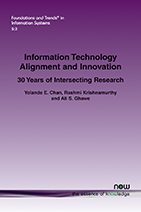Information Technology Alignment and Innovation: 30 Years of Intersecting Research
By Yolande E. Chan, Smith School of Business, Queen’s University, Canada, ychan@queensu.ca | Rashmi Krishnamurthy, Smith School of Business, Queen’s University, Canada, r.krishnamurthy@queensu.ca | Ali S. Ghawe, Smith School of Business, Queen’s University, Canada, ali.ghawe@queensu.ca
Abstract
Business-IT alignment (hereafter alignment) and information technology-enabled innovation (hereafter innovation) are essential for firm performance and competitive advantage. During the past 30 years, alignment and innovation literature streams have grown and become important areas of inquiry in the Information Systems field. Nevertheless, both literature streams have remained separate; it is unclear where and how the two streams overlap. To our knowledge, none of the existing review articles has systematically examined this overlap or how each literature stream informs the other. In this monograph, we bridge this gap and present findings from a review of the alignment and innovation literature streams published between 1990 and 2020 in the Senior Scholars’ Basket of Eight Journals of the Association for Information Systems. We summarize approaches, challenges, and opportunities seen in the alignment and innovation literature streams. Our analysis reveals that alignment scholars tend to overlook the complexities inherent in the process of innovating and view innovation as a black box. Meanwhile, innovation scholars assume different organizational components during the innovation process seamlessly work together to support alignment. We conclude that scholars in both camps should consider undertaking studies that examine aligning and innovating as interdependent processes: aligning involves coordination and cooperation among business units, and in many cases, innovations are needed to achieve alignment. Similarly, innovating with information technology jolts the organization out of its previous alignment and requires aligning in parallel to innovating to restore alignment. We end the monograph by presenting guidance to both scholars and practitioners interested in alignment and IT-enabled innovation.
Information Technology Alignment and Innovation: 30 Years of Intersecting Research
Business-IT alignment and information technology-enabled innovation are essential for firm performance and competitive advantage. Over the last 30 years, alignment and innovation literature streams have grown and become important areas of inquiry in the Information Systems field. However, both literature streams have remained separate, and it is unclear where and how the two streams overlap. None of the existing reviews have systematically examined this overlap or how each literature stream informs the other. This monograph bridges this gap and presents findings from a review of the alignment and innovation literature streams published between 1990 and 2020. The authors summarize approaches, challenges, and opportunities seen in the alignment and innovation literature streams.
The analysis reveals that alignment scholars tend to overlook the complexities inherent in the process of innovating and view innovation as a black box. Meanwhile, innovation scholars assume different organizational components during the innovation process seamlessly work together to support alignment. The authors conclude that scholars in both camps should consider undertaking studies that examine aligning and innovating as interdependent processes: aligning involves coordination and cooperation among business units, and, in many cases, innovations are needed to achieve alignment. Similarly, innovating with information technology jolts the organization out of its previous alignment and requires aligning in parallel to innovating to restore alignment. Information Technology Alignment and Innovation: 30 Years of Intersecting Research provides guidance to both scholars and practitioners interested in alignment and IT-enabled innovation.
